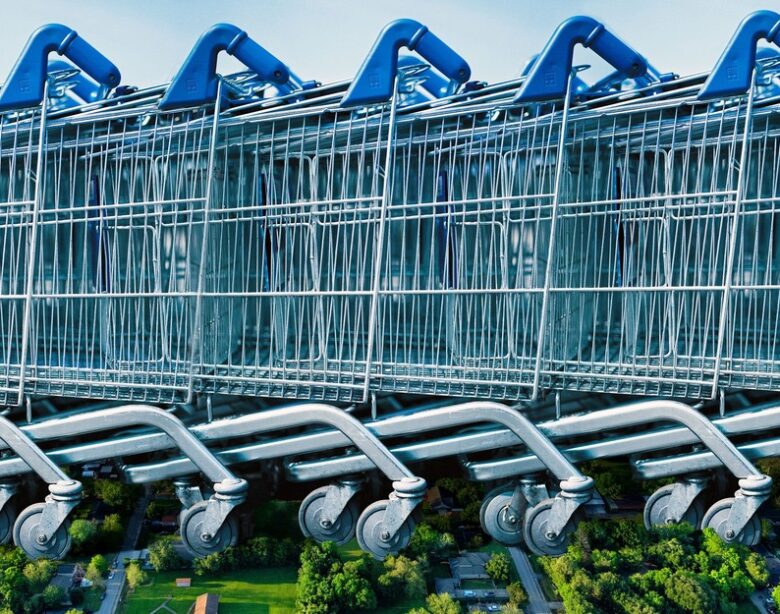[ad_1]
There is no company. weaving machine As large as Walmart is to the American economy, it is the nation’s largest private employer. which is known for its low wages and the nation’s largest retailer known for its low prices. In that sense, its dominance represents a victory for the ideas that have guided much of American policy over the past half century. That is, cheap consumer prices are the most important indicator of economic health. It’s even more important than low unemployment and high wages. Indeed, many of Walmart’s defenders argue that the company is a boon for poor and middle-class families. That saves thousands of dollars every year shopping there.
Two new research papers challenge that view. By using new and creative methods They found that the costs Walmart imposes do not only come in the form of reduced revenue. but also higher unemployment in the wider community. This goes beyond the savings offered to buyers. They concluded online that Walmart had left the locations it operated in worse shape than it would have been if it never appeared. Consumer prices can sometimes be an imperfect or even misleading indicator of economic well-being.
In the 1990s and early 2000s, before tech giants dominated the discourse about corporate power, Walmart was a hot political topic. Documentaries and books are widespread with titles such as: Wal-Mart: High costs, low prices. and How Walmart is destroying America (and the world)– The publicity is so bad that Walmart build “War Room” in 2005, which was dedicated to improving its image.
When the cavalry came, it was from the economics elite: In 2005, Jason Furman, who would go on to chair Barack Obama’s Council of Economic Advisers, published a report. paper In the report’s “Wal-Mart: Breakthrough Success Story,” he argued that even though Walmart pays its workers relatively low wages, “the scale of the potential harm pales in comparison to the amount it can save.” He got it at the grocery store.” This became the prevailing view among many economists and policymakers over the next two decades.
However, fully evaluating the impact of an organization as iconic as Walmart is a complex task. The cost savings for consumers are easy to calculate. But without considering the company’s overall impact on the community, Walmart’s arrival has had an impact on the local economy. Make consumers change their shopping habits Employee changes jobs Competitors change strategies and suppliers change output
Two new working papers use a new method to dissect Walmart’s economic impact, and what they find doesn’t look like a breakthrough success story at all. first onePosts in September by social scientists Lukas Lehner and Zachary Parolin and economists Clemente Pignatti and Rafael Pintro Schmitt draw out unique details. Data set It tracks a wide range of outcomes for more than 18,000 individuals across the United States. Back in 1968, this wealth of data enabled Parolin and his co-authors to create the economic equivalent of clinical trials for medicine: They matched two demographically comparable groups of Individuals inside the data set and observed what happened when one group received the “treatment” (Walmart opening) and another group did not.
Their conclusion: During the 10 years after a Walmart Supercenter opened in a community, The average household in that community has a 6 percent lower annual income, or about $5,000 per year in 2024 dollars, than households that do not have a Walmart open near them. Young, low-income workers and those who received little education suffered the greatest loss.
In theory, however, those people might still be better off with the money they earn. Saved Shopping at Walmart is more than their income. According to a 2005 study commissioned by Walmart itself, the store could save households an average of $3,100 per year by 2024 dollars, according to several economists. think The estimate was very generous. (which is not surprising (When considering who funded the study), but even if they were accurate, Parolin and co-authors found that the savings would be smaller with lost income. They calculated that poverty increased about 8 percent in places where Walmart was open compared to places where there weren’t any. This is despite the most optimistic cost-savings scenario.
But their analysis may have a weakness: It can’t account for the possibility that Walmarts aren’t evenly distributed. For any reason Companies may choose communities based on factors that are difficult to detect, such as deindustrialization or union abolition. which incentivizes those places to increase poverty in the first place. That’s how the second person works. paperA post from last December came in. In it, economist Justin Wiltshire compared the economic trajectories of counties where Walmart is open to those of counties where Walmart is not. try It opened but failed due to local opposition. In other words, if Walmart chooses locations based on hidden characteristics, Those counties should all have those locations. Still, Wiltshire saw similar results: workers in counties where Wal-Marts were open There were more revenue drops than they were offset by cost savings. Resulting in worse overall What’s even more interesting is that He found that the losses weren’t limited to workers in the retail industry. Essentially, they affect every sector from manufacturing to agriculture.
What happened here? Why does Walmart have such a negative impact on incomes and wealth on a large scale? The theory is complex and goes like this: When Walmart comes to town, it uses low prices to undercut competitors and become the dominant player in the given area. Force local mom-and-pop merchants and regional chains to cut costs? They have all gone out of business. As a result, local farmers, bakers and producers who once sold their goods to retailers are now slowly disappearing. replaced by Walmart’s domestic and international suppliers (by some estimates the company has a history of Origin (An estimated 60 to 80 percent of the company’s products come from China alone.) As a result, Wiltshire found that, five years after Walmart entered a county, Total employment fell about 3 percent, with most of the decline focused on “Establishment that produces products”
When Walmart became a major employer in the city It ends with what economists call “monopoly power” over workers, as well as monopoly Describes a company that is able to charge exorbitant prices because there is no real competition. exclusivity Describes companies that can afford low wages. This is because workers have very few options. This helps explain why Walmart continues to exist. pay Wages are lower than competitors like Target and Costco and regional grocers like Safeway. “The thing about Walmart is that it goes against the perfect competitive market model that we teach in Econ 101,” Wiltshire told me. “It is hard to think of a clear example of an employer using its power over workers to suppress wages.”
Walmart’s size also gives it leverage over the manufacturers that supply it, according to Stacy Mitchell, co-director of the Institute for Local Self-Reliance. Recently written atlantic oceanWalmart is so well known for squeezing out suppliers that it has little choice but to do so. Follow For fear of losing key customers, selling to Walmart at such low prices could force local suppliers to lay off employees and pay lower wages to those who remain. They also Try to make up for the shortfall by charging other customers. at a higher price This creates a vicious cycle that allows Walmart to seize its power even further.
The most direct result of new research is that Walmart isn’t quite the bargain for American communities it appears to be. (When I contacted Furman about this new research He said he wasn’t sure what to do. (And suggested I talk to labor economists.) The findings raise broader questions about how legal and conceptual changes are enabling Walmart and other behaviors To be great from the beginning In the late 1970s, antitrust regulators and courts adopted what are known as consumer welfare standards. This is considered an appropriate benchmark for whether a company is too large or not. Or whether the merger will undermine competition or not. Will it increase the consumer price or decrease the seller’s price? Output, in other words. The objective of competition law has been redefined as of as much as possible As cheap as possible– But as new Walmart research points out, such formulas don’t always guarantee maximum welfare for American consumers.
The outgoing Biden administration which focuses on antitrust rehabilitation. accept this Recent regulatory guidance, for example, requires governments to consider the impact of mergers on workers. Not just consumers And antitrust authorities have included such claims in several lawsuits. The question is whether the incoming Trump administration, which has sent mixed messages about corporate consolidation, will follow the same path.
Recent history shows the political dangers of threatening low consumer prices. Public reaction to inflation in recent years suggests that many Americans would rather be slightly poorer but have more price stability than richer but have more inflation. This will tempt policymakers to prioritize low prices above all else. and accept companies that offer those bids But if Walmart’s example reveals anything, it’s that in the long run, low prices can have a cost of their own.
[ad_2]
Source link



